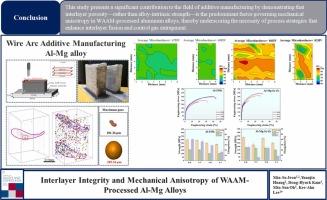Interlayer Integrity and Mechanical Anisotropy of WAAM-Processed Al-Mg Alloys
IF 6.3
2区 材料科学
Q2 CHEMISTRY, PHYSICAL
引用次数: 0
Abstract
Wire Arc Additive Manufacturing (WAAM) has emerged as a promising technique for fabricating large-scale aluminum alloy components, owing to its high deposition efficiency, low material waste, and accessible equipment requirements. It shows particular potential for structural applications in the aerospace and transportation sectors. However, porosity formed during multi-layer deposition often induces pronounced mechanical anisotropy, undermining structural integrity. This study systematically evaluates the microstructural features, pore formation, and mechanical performance of two representative WAAM-deposited aluminum alloys: Al-5356 and Al-Mg-Sc-Zr. The Al-Mg-Sc-Zr alloy exhibited refined grains (~15 μm) and strengthening from Al₃(Sc,Zr,Ti) precipitates, but also showed severe interlayer porosity (~1%), which caused a marked reduction in vertical strength and ductility (UTS dropped by ~30%, elongation by ~75%). In contrast, the Al-5356 alloy displayed coarse grains (~95 μm), very low porosity (~0.02%), and relatively consistent properties in both orientations. These results demonstrate that, although microalloying enhances intrinsic strength, the dominant factor governing anisotropy in WAAM-fabricated aluminum alloys is the spatial distribution of interlayer porosity. The findings highlight the critical importance of optimizing interlayer fusion and gas management strategies to fully exploit WAAM for high-performance aluminum applications.

waam加工Al-Mg合金的层间完整性和力学各向异性
电弧增材制造(WAAM)由于其高沉积效率、低材料浪费和易于使用的设备要求,已成为制造大型铝合金部件的一种有前途的技术。它在航空航天和运输部门的结构应用方面显示出特别的潜力。然而,在多层沉积过程中形成的孔隙往往会引起明显的力学各向异性,破坏结构的完整性。本研究系统地评价了两种具有代表性的waam沉积铝合金Al-5356和Al-Mg-Sc-Zr的显微组织特征、孔隙形成和力学性能。Al- mg -Sc-Zr合金晶粒细化(~15 μm), Al₃(Sc,Zr,Ti)析出强化,但层间孔隙率严重(~1%),导致合金纵向强度和延展性明显降低(UTS下降~30%,伸长率下降~75%)。Al-5356合金晶粒粗大(~95 μm),孔隙率极低(~0.02%),两取向性能相对一致。结果表明,微合金化虽然提高了本构强度,但影响waam铝合金各向异性的主要因素是层间孔隙率的空间分布。研究结果强调了优化层间融合和气体管理策略的重要性,以充分利用WAAM用于高性能铝应用。
本文章由计算机程序翻译,如有差异,请以英文原文为准。
求助全文
约1分钟内获得全文
求助全文
来源期刊

Journal of Alloys and Compounds
工程技术-材料科学:综合
CiteScore
11.10
自引率
14.50%
发文量
5146
审稿时长
67 days
期刊介绍:
The Journal of Alloys and Compounds is intended to serve as an international medium for the publication of work on solid materials comprising compounds as well as alloys. Its great strength lies in the diversity of discipline which it encompasses, drawing together results from materials science, solid-state chemistry and physics.
 求助内容:
求助内容: 应助结果提醒方式:
应助结果提醒方式:


